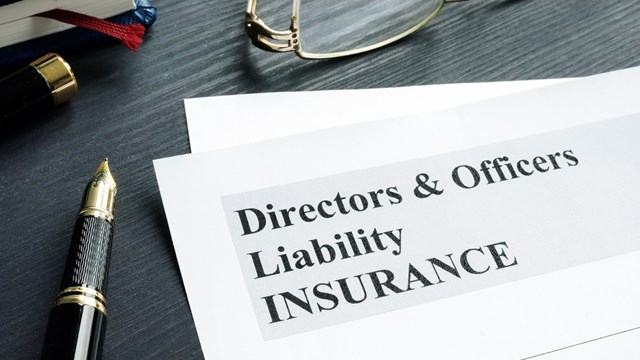
When you decide to run for a board, you’re usually thinking about all the great changes you’re going to make to your building community, along with all the time and effort that you’re prepared to sacrifice for the good of your home.
Of the many thousands of dollars a large condominium, co-op, or homeowners association may spend each year on insurance, two policies that typically cost less than five percent of the total are two of the most vital: crime insurance (often called fidelity coverage) and directors and officers liability insurance (often called simply D&O).
It sounds confusing and complicated—but boards must understand what each type of policy covers and what they don’t cover.
First Things First
First, there’s general liability coverage, which protects the association if someone is hurt on the property. This one is straightforward. But fidelity bond insurance and D&O insurance can seem more complicated to understand. Essentially, they are there to protect the board against lawsuits.
Fidelity bond insurance or crime insurance is typically a stand-alone policy or is included within a package policy that protects an association from any theft or misappropriation of funds by people entrusted to handle them.
Fidelity bond insurance protects boards and other building administrators from malfeasance carried out by building or homeowner association staff members. New Federal Housing Administration (FHA) requirements now provide that condos must have this insurance—so not only must boards consider it—but they must research it, purchase it and renew it.
Most insurance professionals agree that fidelity coverage is one of the most neglected and misunderstood areas of insurance for an association. This type of coverage is also known as employee dishonesty coverage or crime coverage. Having three different names doesn’t help the matter, and often, insurance agents use fidelity, crime and employee dishonesty interchangeably, just to confuse the matter further.
Directors & Officers Protection
D&O coverage is necessary to protect boards from legal actions and damages resulting from their own good-faith decisions. It essentially protects the board from any liability related to alleged errors in judgment or other wrongful acts while doing their job in good faith on the board. D&O will pay sums that the insured (condo, association and its directors and officers) are legally obligated to pay because of a wrongful act. A wrongful act is described as a breach of duty, neglect, error, misstatement or omission committed by directors or officers of the association.
We all know that we live in a highly litigious society. Some resident’s complaints may seem ridiculous but those complaints can spur litigation, and unfortunately the target of that litigation is more than likely to be the unsuspecting board members.
According to David Byrne, a partner with the law firm of Herrick Feinstein, LLP., located in Princeton, directors and officers insurance, more commonly known as, D&O insurance, is your own personal protective helmet from fastball lawsuits. “It provides you with a lawyer to defend against claims if you get sued, but it doesn't protect anybody from criminal actions, such as fraud or self-dealing,” says Byrne.
He explains that it protects the board from all sorts of action, whether it's regarding fiduciary duties, rule enforcement, discrimination, etc. The coverage is vital and I don't know why anyone would volunteer to serve on a board without that protection, he says.
“What it does cover, for the most part, are things like employment discrimination, architectural disputes, inadequate reserves, negligence, third-party breach of contract, arguments of reassessments, liens, defamation, basically various types of breach of fiduciary duty,” says Paul Felsen of Felsen Insurance Services, Inc. in Denville. “There are literally hundreds of actions that can be brought against a board member these days when people are unhappy. Every policy is different, and every policy has different exclusions. A typical exclusion would be any act that's deliberately dishonest or fraudulent, any willful violation of the statute or regulation.
“Normally, if an action is brought against the property manager, the manager is usually included under the D&O policy, but the coverage sometimes will fall under the property manager's professional liability coverage,” Felsen continues. “This is not a professional liability coverage for the property manager per se, or the property management company, but it includes the property manager as an additional insured, though the coverage is not broader than what that would be for the board itself.”
Who Else is Covered?
D&O covers managers as well. A well-constructed D&O policy is supposed to cover not only board members and managers, but former board members, volunteers, spouses and independent contractors, according to Joel Meskin, CIRMS, vice president of community association insurance and risk management at McGowan Program Administrators, a nationwide managing general underwriter based in Fairview Park, Ohio, which provides coverage in New Jersey, “The managing agent should be covered, preferably in the definition of the insurance, not as an additional endorsement,” he adds.
In today’s world, according to all concerned, directors’ and officers’ insurance is basically a necessity.
“Anyone who serves on a board that doesn’t have D&O insurance has got to be nuts,” says Bernie Gitlin of Risk Strategies Company, a risk management consulting firm, which has offices in Massachusetts, New York City, Chicago and California. “People can be attacked for all sorts of reasons. There are controversies about what you should have done in terms of management, what you should have fixed; any number of things.”
What Could Happen?
Several scenarios could result in D&O claims. One example could happen when a board invests an association’s funds, without prior investigation, into a business that later goes bankrupt. Another could happen when the board fails to pay property taxes on time.
Other examples could result from the always-contentious pet issue. For example, someone might complain to the board that a fellow association member has a dog and that is against the association’s rules and regulations. The board sues the dog owner but then the dog owner turns around and sues the board, saying the rule is discriminatory. The board has expended money defending its house rules, but if the court rules in favor of the resident, the board is protected by its D&O insurance policy.
Meskin feels the most common D&O claims involve challenges. These can include challenges to architectural review decisions, challenges to elections, challenges to assessments or challenges against an association for breach of vendor contracts.
Claims could arise from alleged failure by the board to properly maintain the premises. Or a claim could result from an alleged discriminatory application of the rules and regulations.
The most common challenges to a board are accusations of misappropriation of funds, or any decisions that might interfere with a unit owner’s quality of life. For example, a board might decide that they want to install new roofs, pushes forward and decides to authorize the expenditure. What can happen, and commonly does, is that one of the board members objects to the decision and tries to fight it through litigation.
What It Doesn’t Cover
The above are situations that might fall under a D&O policy. There are some situations, however, that D&O insurance doesn’t cover. For example, personal liability is not included—if someone slips and falls, the association’s general liability policy comes into play instead. In general, bodily injury and property damage are not covered under D&O policies. Construction defect claims are also not generally covered under D&O, but, again, fall under the general liability policy.
And, needless to say, directors’ and officers’ insurance doesn’t cover fraud by board members or “self-dealing.” When a board member or manager takes advantage of his or her position and tries to help himself or herself personally rather than acting in the best interests of the association—that’s not covered by D&O.
“A key coverage that property managers are generally not aware of is that if the association itself sues the property manager, they [the association] will not provide coverage,” Meskin adds, “as opposed to when a third party sues the association, which may be covered under D&O.
Questions to Ask
If no details are offered beyond the name of the type of coverage and the coverage limit, it is suggested that the board ask the insurance agent the following questions:
Does this policy include coverage for volunteers, committee members and prior D&O members? Is coverage included for the management team? If not, how much would it cost to add the extra coverage?
Is the policy occurrence or claims made, and is there a retroactive date?
What exclusions are on the policy, and is there an insurance exclusion that can be deleted?
Before agreeing to the policy, always ask to review a sample policy so you can go over the details and make sure this will include what’s necessary for your particular building.
One big issue would be third party liability, says Michael Rubin, president of The Rubin Group, a New York City-based insurance company. For example, if a minority vendor approaches your building and offers to clean it for 20 percent less than your current cleaning service—and your building declined his services, he could sue the building for discrimination. Since he would be a third party, the D&O insurance policy may or may not cover your building, depending on your coverage.
“A typical policy may not cover that,” Rubin says. “An upgraded policy may cover that. Like anything in life, you get what you pay for.”
That doesn’t mean that you need to overpay, nor does it mean that spending a couple hundred dollars will do the job. Rubin suggests getting four or five quotes before deciding on the right policy for the building.
When the insurance company determines the cost of your building’s policy, they’re looking at two factors: the total number of units in the building and the number of prior claims. An association with a building that has 50 units would expect to pay about $800, while one with 50 units and one prior claim may have a premium of $1,000 plus a higher deductible (perhaps $2,500 per claim instead of $1,000 per claim). “The premiums are based on the number of units and are paid for by the association,” he explains.
The last step before signing on the dotted line should be checking out the insurance companies’ ratings. This can be done at www.Ambest.com. If you’re looking for an insurance agency specializing in insuring associations, you can get more information from the following organization, the Community Associations Institute – New Jersey Chapter at www.cainj.org or log onto The New Jersey Cooperator’s website for the online Directory of Condo & HOA Services as http://www.directory.njcooperator.comOperating a fair, open, and judicious board is the first line of defense against any lawsuit—and a good D&O policy and fidelity coverage can help provide the protection your community needs.
Danielle Braff is a freelance writer and a frequent contributor to The New Jersey Cooperator. Associate Editor Liam P. Cusack contributed to this article.






Leave a Comment